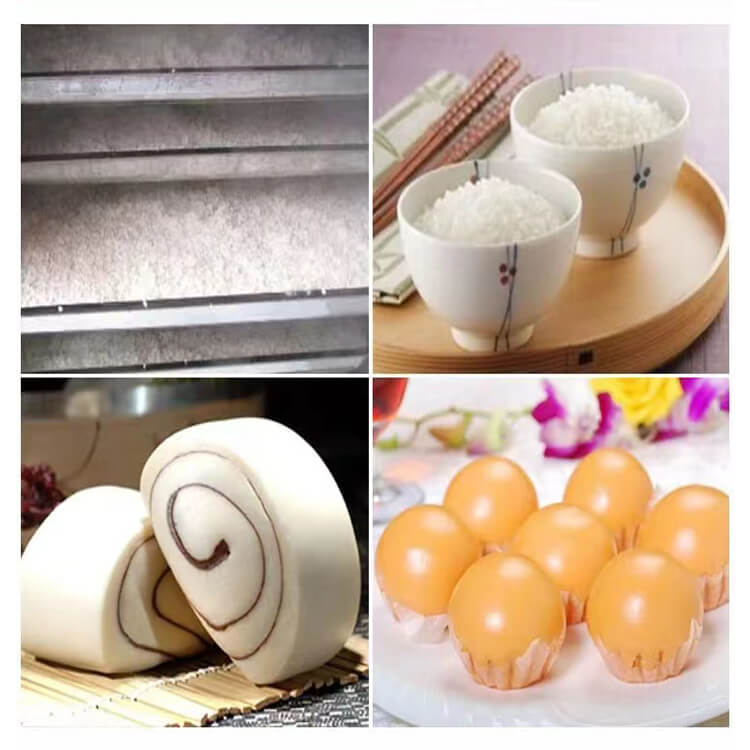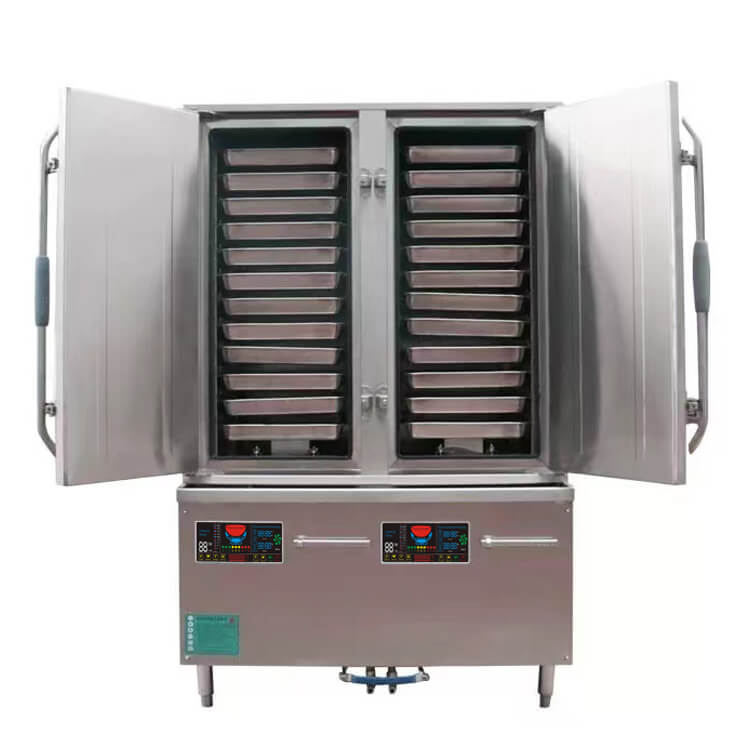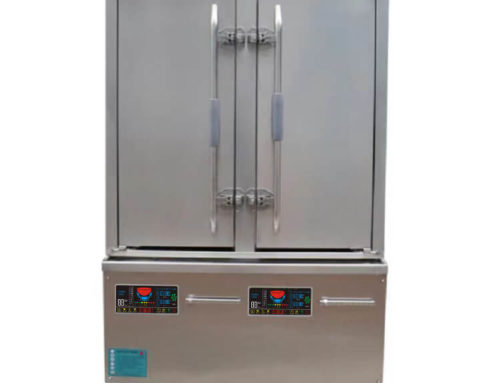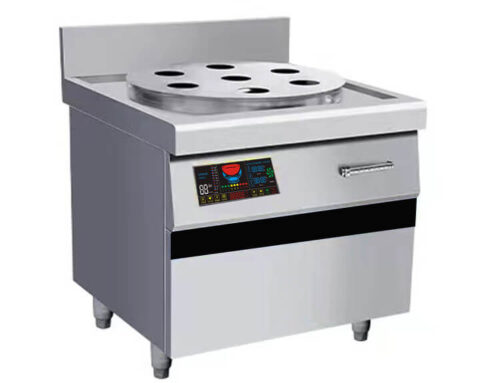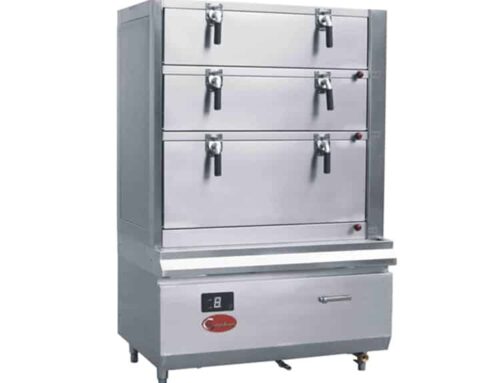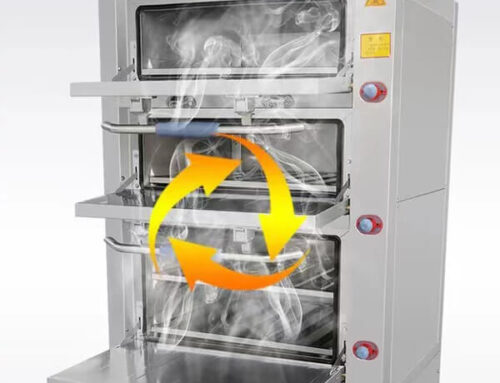What Electric Steamer Production Capacity Do I Need Based on My Expected Meal Volume?
Choosing the right electric steamer capacity is a make-or-break decision for commercial kitchens—too small, and you’ll face bottlenecks during peak service; too large, and you’ll waste energy, space, and money on underused equipment. The key is aligning the steamer’s production capacity (measured by tray count, hourly output, and batch size) with your expected meal volume—whether you’re a small café serving 50 daily meals or a banquet hall handling 1,000+ guests.
AT Cooker, a leading provider of commercial steamer solutions, offers a range of models tailored to different volume needs: from 3-tray countertop steam cooker units for low-volume use to 48-tray industrial commercial kitchen steamer systems for high-capacity operations. Each model’s capacity is engineered to balance speed, efficiency, and quality—ensuring you can keep up with demand without sacrificing food texture or nutrition.
Below, we break down capacity recommendations by meal volume (low, medium, high), explain how to calculate your exact needs (including buffer capacity for surges), and link each category to AT Cooker’s specific models with real-world examples. We also cover critical factors that influence capacity choices, like menu diversity, kitchen layout, and long-term scalability—so you can invest in an electric steamer that grows with your business.
1. Low-Volume Operations (Under 100 Meals/Day): Compact 2-4 Pan Countertop Electric Steamers
Low-volume kitchens—such as small cafés, food trucks, or boutique bakeries—typically serve 50–100 meals daily, with peak demand of 20–30 meals per hour. For these operations, a compact countertop electric steamer (2–4 trays) is ideal: it fits in limited space, uses less energy, and produces enough batches to avoid service delays without overcomplicating operations.
AT Cooker’s ZFGT-E1 Electric Steam Oven Countertop is a perfect match for low-volume needs. This 3-tray model (6 KW power) has a compact footprint (W65×D73×H75 cm)—small enough to fit on standard countertops—and can produce ~150 servings of rice, dumplings, or veggies daily (based on 120g per serving). Key specs that support low-volume efficiency:
- Tray Capacity: 3 trays (size 525×325×40 mm), each holding ~1.5kg of uncooked rice (yields ~4.5kg cooked rice → 37.5 servings per tray).
- Hourly Output: 2 batches per hour (cooking time ~25 minutes for rice), totaling ~225 servings/hour (though low-volume kitchens rarely need full capacity).
- Energy Efficiency: 6 KW power—uses ~0.25 KW per serving, far less than larger models.
A small café in Portland uses the ZFGT-E1 to serve 80 daily meals: “We steam rice, dumplings, and veggies for breakfast and lunch. The 3-tray steamer lets us cook one batch for breakfast (30 servings) and two batches for lunch (60 servings)—no rush, no waste. Before, we used a small pot steamer and had to cook 5 batches daily, which took twice as long.”
2. Medium-Volume Kitchens (100–300 Meals/Day): 6–8 Pan Stackable Commercial Steamers
Medium-volume operations—including mid-sized restaurants, hotels, and school cafeterias—serve 100–300 meals daily, with peak demand of 50–80 meals per hour. These kitchens need a commercial steamer that balances capacity and flexibility: stackable or freestanding models with 6–18 trays, capable of handling multiple batches simultaneously while leaving room for menu diversity (e.g., steaming rice, dim sum, and seafood at the same time).
AT Cooker offers two standout models for medium volume:
- ZFGT-E3 Commercial Electric Steamer (9 Trays): A freestanding 9-KW model with 9 trays (size 525×325×40 mm), producing ~450 servings daily. Each tray holds ~2kg uncooked rice (yields ~6kg cooked → 50 servings per tray), with 2 batches per hour (total ~900 servings/hour—more than enough for 300 daily meals). Its footprint (W73×D80×H161 cm) fits in most standard kitchens, and it uses 9 KW power (0.02 KW per serving).
- ZFGT-E6 Electric Commercial Steam Oven (18 Trays): For growing medium-volume kitchens, this 36-KW model with 18 trays produces ~900 servings daily. It’s ideal for restaurants adding dinner service or expanding their menu—capable of steaming 3 different items (e.g., rice on trays 1–6, dumplings on 7–12, seafood on 13–18) without flavor cross-contamination.
A hotel in Denver uses the ZFGT-E3 to serve 250 daily meals (breakfast and dinner): “We cook 100 servings of rice for breakfast and 150 servings of mixed dim sum for dinner. The 9-tray steamer lets us cook breakfast in one batch and dinner in two batches—no more scrambling during peak hours. We used to rent an extra steamer for weekends; now the ZFGT-E3 handles it all.”
Menu diversity is a key consideration here: if you serve 300 meals but 50% are steamed items (150 servings), a 9-tray steamer is sufficient. If 100% are steamed (300 servings), opt for 18 trays to avoid cooking back-to-back batches.
| AT Cooker Electric Steamer Model | Tray Count | Daily Meal Capacity (120g/serving) | Peak Hourly Output | Power | Ideal Kitchen Type (Meals/Day) |
|---|---|---|---|---|---|
| ZFGT-E1 (Countertop) | 3 | 150–200 | 75–100 | 6 KW | Cafés, food trucks (50–100) |
| ZFGT-E3 (Freestanding) | 9 | 450–500 | 225–250 | 9 KW | Restaurants, small hotels (100–300) |
| ZFGT-E6 (Freestanding) | 18 | 900–1,000 | 450–500 | 36 KW | Large restaurants, banquet halls (300–600) |
| ZFGT-R 24 (Industrial) | 24–48 | 1,200–2,400 | 600–1,200 | 20–25 KW | Stadiums, catering companies (600+) |
3. High-Capacity Operations (300+ Meals/Day): 10–20 Pan Modular or Double-Stack Electric Steamers
High-capacity kitchens—banquet halls, stadiums, catering companies, and large hotel chains—serve 300+ meals daily, with peak demand of 100+ meals per hour. These operations need a commercial food steamer that delivers massive output without compromising speed or quality. Modular systems (expandable tray counts) or double-stack configurations are ideal here, as they let you scale capacity and handle multiple menu items simultaneously.
AT Cooker’s ZFGT-R 24 Commercial Rice Steamer Machine is the gold standard for high volume. This industrial model offers 24–48 trays (expandable via modular add-ons) and produces 1,200–2,400 servings daily. Key features that support high-capacity needs:
- Modular Tray Design: Start with 24 trays (1,200 servings/day) and add up to 48 trays (2,400 servings/day) as demand grows—no need to replace the entire unit.
- Automatic Filling Water: Large 50L water tank with auto-refill ensures uninterrupted operation during 4-hour banquet services—no staff needed to monitor water levels.
- Multi-Zone Temperature Control: Independently controlled chambers let you steam rice at 100℃, seafood at 95℃, and dim sum at 98℃ simultaneously—critical for high-volume menus with diverse items.
A catering company in Los Angeles uses the 48-tray ZFGT-R 24 to serve 1,500+ guests at weddings: “We used to rent 6 small steamers for large events—now we use one 48-tray unit. It cooks 500 servings of rice, 300 servings of dumplings, and 700 servings of veggies in 3 batches, saving us 4 hours of prep time. The modular design also lets us use 24 trays for smaller events, so we don’t waste energy.”
For even higher output (2,400+ servings/day), AT Cooker offers double-stack configurations (two ZFGT-R 24 units stacked vertically), which double capacity while using the same floor space as one unit. This is ideal for stadiums or convention centers with fixed kitchen layouts.
4. Batch Cooking Capacity: Ensuring Service Continuity During Peak Hours
Production capacity isn’t just about total daily output—it’s about batch cooking capacity: how many meals you can cook in one cycle and how quickly you can start the next batch. For commercial kitchens, this directly impacts service continuity: if a steamer’s batch size is too small, you’ll spend more time refilling trays than serving customers, leading to long wait times and frustrated guests.
AT Cooker’s steamers are engineered to maximize batch efficiency, with features that reduce downtime between batches:
- Fast Steam Recovery: High-power boilers (e.g., 36 KW in the ZFGT-E6) generate full steam pressure in 2–3 minutes after a batch is removed—cutting wait time between cycles by 70% compared to traditional steamers.
- Easy Tray Access: Sliding tray racks (standard on all models) let staff remove cooked trays and add new ones in 1–2 minutes—no heavy lifting or awkward maneuvering.
- Cook/Hold Functionality: Advanced models (like the ZFGT-R 24) let you hold cooked food at 90–95℃ for up to 4 hours—so you can cook batches in advance and serve them as needed, reducing peak-hour stress.
A diner in Chicago tested batch efficiency with the ZFGT-E3 (9 trays): “We used to cook 30 servings per batch with our old steamer, and it took 10 minutes to start the next batch. The ZFGT-E3 cooks 450 servings per batch and recovers steam in 2 minutes—we now serve 50% more customers during lunch rush without adding staff.”
For batch planning, use this rule of thumb: batch size should equal 30% of your peak hourly demand. If you serve 80 meals per hour at peak, each batch should produce ~24 meals. The ZFGT-E3’s 9 trays (450 servings/day ÷ 6 peak hours = 75 servings/hour) aligns perfectly with this standard.
5. Modular Steamers: Expanding Capacity as Meal Volume Grows
Many kitchens start small but plan to grow—investing in a fixed-capacity electric steamer now can lead to costly replacements later. Modular steamers solve this by letting you add trays or chambers as meal volume increases, making them a flexible, future-proof choice.
AT Cooker’s modular options include:
- ZFGT-R 24 Modular Trays: Start with 24 trays (1,200 servings/day) and add 12-tray modules to reach 36 or 48 trays (1,800–2,400 servings/day). Each module connects to the main unit’s power and water supply—no new wiring or plumbing needed.
- Stackable Units: The ZFGT-E3 and ZFGT-E6 can be stacked vertically with a custom bracket kit, doubling capacity (e.g., two ZFGT-E3 units = 18 trays, 900 servings/day) while using the same floor space.
A growing restaurant in Austin started with a 9-tray ZFGT-E3 (450 servings/day) and added a second unit after 6 months: “We went from 200 to 400 meals daily, and stacking the ZFGT-E3 units let us double capacity without rearranging our kitchen. If we grow to 600 meals, we’ll add a 18-tray ZFGT-E6—no need to sell our old unit.”
Modular steamers also save money in the long run: the cost of adding a 12-tray module ($1,500) is far less than buying a new 48-tray steamer ($8,000). They’re also easier to maintain—if one module fails, you can still use the others, avoiding complete downtime.
Start (200 Meals/Day)
ZFGT-E3 Electric Steamer
450 Servings/Day Capacity
Grow (400 Meals/Day)
2× ZFGT-E3 Stacked
900 Servings/Day Capacity
Scale (800 Meals/Day)
ZFGT-R 24 Modular
2,400 Servings/Day Capacity
6. Cook/Hold Functionality: Supporting Staggered Meal Services
Not all meals are served at once—hospitals, schools, and hotels often have staggered service times (e.g., breakfast from 7–10 AM, lunch from 12–2 PM). For these operations, commercial steamer models with cook/hold functionality are critical: they let you cook large batches in advance and hold food at safe, quality-preserving temperatures until service—eliminating the need to cook multiple small batches.
AT Cooker’s cook/hold feature (standard on ZFGT-E6 and ZFGT-R 24 models) works by:
- Cooking food at the optimal temperature (e.g., 100℃ for rice) until done.
- Automatically reducing temperature to 90–95℃ (FDA-safe for hot holding) and maintaining it for up to 4 hours.
- Using moisture retention technology to prevent food from drying out—rice stays fluffy, and dumplings stay soft.
A hospital cafeteria in Boston uses the ZFGT-E6’s cook/hold function to serve 300 patients over 3 hours: “We cook 300 servings of rice at 6 AM, hold it until 9 AM, and it tastes as fresh as if it was just cooked. Before, we cooked 100 servings at 7 AM, 100 at 8 AM, and 100 at 9 AM—wasting 2 hours of staff time.”
Cook/hold functionality also reduces food waste: advance cooking lets you adjust portions based on early demand, and holding keeps food safe to serve even if service runs late. For kitchens with staggered service, this feature can reduce daily cooking time by 30%.
— Sarah, Catering Company Owner (Los Angeles, CA)
7. Menu Diversity: Adjusting Capacity for Mixed Items
Your menu directly impacts electric steamer capacity needs: a kitchen serving only rice can use every tray for one item, but a kitchen serving rice, dumplings, seafood, and veggies needs separate trays (or chambers) for each—reducing the effective capacity for any single item.
For example, a restaurant serving 300 meals daily with a diverse menu (50% rice, 30% dumplings, 20% seafood) needs to allocate trays accordingly:
- Rice: 150 servings → 3 trays (50 servings/tray).
- Dumplings: 90 servings → 3 trays (30 servings/tray, as dumplings take more space).
- Seafood: 60 servings → 2 trays (30 servings/tray, as seafood needs taller trays).
- Total trays needed: 8 → A 9-tray ZFGT-E3 is sufficient (with 1 tray spare for surges).
AT Cooker’s steamers accommodate menu diversity with:
- Adjustable Tray Heights: The ZFGT-E6 and ZFGT-R 24 let you widen tray gaps for tall items (e.g., seafood baskets) or narrow them for small items (e.g., dumplings).
- Multi-Zone Chambers: The ZFGT-R 24 has 3 independent chambers, each with its own temperature control—cook rice at 100℃, dumplings at 98℃, and seafood at 95℃ without cross-contamination.
- Specialized Trays: Optional perforated trays for seafood (to drain excess moisture) and non-stick trays for dumplings (to prevent sticking) maximize capacity for each item.
A dim sum restaurant in New York uses the ZFGT-R 24’s multi-zone chambers: “We serve 10 types of dim sum daily, and the 3 chambers let us cook 3 items at once. Before, we used 3 small steamers and had to manage 3 different temperature settings—now it’s all in one unit, and we’ve cut cooking time by 40%.”
8. Energy Efficiency: Balancing Capacity and Operational Costs
Capacity and energy use go hand in hand—larger electric steamer models use more power, but high-efficiency designs can keep operational costs low. AT Cooker’s steamers are engineered to optimize energy use per meal, so even large models are cost-effective for high-volume operations.
Key energy-saving features include:
- Heat Recovery Systems: Condensate (water from steam) is collected and reused to preheat incoming water, reducing boiler energy use by 22% (standard on ZFGT-E6 and ZFGT-R 24).
- Variable Frequency Drives (VFD): Adjust power based on batch size—e.g., the ZFGT-R 24 uses 25 KW for 48 trays but only 15 KW for 24 trays, saving energy when capacity isn’t full.
- Insulated Chambers: 3-layer insulation (ceramic fiber + aluminum foil + stainless steel) reduces heat loss by 70%, so the steamer uses less power to maintain temperature.
A cost comparison of AT Cooker’s models (based on $0.15/kWh and 8 hours of daily use):
- ZFGT-E1 (6 KW): $0.15×6×8 = $7.20/day → $216/month.
- ZFGT-E3 (9 KW): $0.15×9×8 = $10.80/day → $324/month.
- ZFGT-R 24 (25 KW): $0.15×25×8 = $30/day → $900/month.
While the ZFGT-R 24 uses more energy, its cost per meal is lower: $900/month ÷ 1,500 meals = $0.60/meal, vs. $324/month ÷ 300 meals = $1.08/meal for the ZFGT-E3. For high-volume operations, larger, efficient steamers save money in the long run.
9. Kitchen Layout: Ensuring the Steamer Fits Your Space
Even the right capacity commercial kitchen steamer won’t work if it doesn’t fit your kitchen layout. Before choosing a model, measure your available space (floor or countertop) and consider workflow: the steamer should be easy to access for loading/unloading, with room for staff to move around and for water/drain connections.
AT Cooker’s models are designed for different space constraints:
- Countertop Models (ZFGT-E1): W65×D73×H75 cm—fits on standard 24-inch countertops, ideal for kitchens with limited floor space (e.g., food trucks, small cafés).
- Freestanding Models (ZFGT-E3, ZFGT-E6): W73–148×D80×H161 cm—need dedicated floor space but fit in most medium-sized kitchens. Leave 30 cm of clearance on all sides for ventilation and access.
- Industrial Models (ZFGT-R 24): W120×D110×H185 cm (24 trays) to W120×D110×H220 cm (48 trays)—best for large kitchens with open floor plans (e.g., banquet halls, stadiums).
A food truck operator in Miami uses the ZFGT-E1: “Our truck’s kitchen is only 6 feet wide, and the countertop steamer fits perfectly next to our grill. We couldn’t use a freestanding model, so the ZFGT-E1 was the only way to add steaming capacity without expanding the truck.”
For tight spaces, consider stackable models (e.g., two ZFGT-E1 units stacked) or under-counter steamers (special order from AT Cooker)—these options maximize vertical space instead of horizontal.
10. Buffer Capacity: Planning for Unexpected Volume Surges
Even the most accurate meal volume forecasts can be off—holidays, events, or viral social media attention can lead to 20–30% surges in demand. To avoid bottlenecks, always add a buffer capacity to your steamer choice: select a model that can handle 20–30% more meals than your expected volume.
For example:
- Expected volume: 100 meals/day → Buffer (30%) = 30 meals → Total capacity needed: 130 meals/day → Choose the ZFGT-E1 (150–200 meals/day).
- Expected volume: 300 meals/day → Buffer (30%) = 90 meals → Total capacity needed: 390 meals/day → Choose the ZFGT-E3 (450–500 meals/day).
- Expected volume: 1,000 meals/day → Buffer (30%) = 300 meals → Total capacity needed: 1,300 meals/day → Choose the ZFGT-R 24 (1,200–2,400 meals/day).
A café in Seattle added buffer capacity after a viral review: “We expected 80 meals/day but got 120 after a local food blogger featured us. Our ZFGT-E1 (150 meals/day) handled the surge—if we’d chosen a smaller steamer, we would have had to turn customers away.”
Buffer capacity also future-proofs your investment: if your business grows by 20% in 6 months, you won’t need to replace your steamer immediately. For most kitchens, a 30% buffer is ideal—large enough to handle surges, small enough to avoid wasting energy on underused capacity.
11. Long-Term Scalability: Investing in Growth
When choosing an electric steamer, don’t just think about today’s meal volume—think about where your business will be in 1–3 years. If you plan to expand (e.g., add a second location, increase menu offerings, or cater larger events), invest in a scalable model that can grow with you.
AT Cooker’s scalable options include:
- Modular Trays: The ZFGT-R 24’s 12-tray modules let you add capacity as you grow—no new unit needed.
- Stackable Units: Start with one ZFGT-E3 and add a second later—doubling capacity.
- Compatible Accessories: Add specialized trays (e.g., for large seafood) or water tanks to increase output without upgrading the base unit.
A restaurant chain with 5 locations standardized on the ZFGT-E6: “We started with one location and 200 meals/day—now we have 5 locations and 1,000 meals/day. The ZFGT-E6’s scalability let us use the same model at every location, simplifying training and maintenance. We just add trays or stack units as each location grows.”
Scalable steamers also reduce long-term costs: the cost of adding modules is far less than buying new units, and standardized models make bulk purchases cheaper.
Choose the Right Electric Steamer Capacity for Your Meal Volume
Share your expected daily meal volume, menu diversity, and kitchen space—our experts will recommend an AT Cooker electric steamer (from countertop to industrial models) that fits your needs today and grows with your business. Get a custom capacity analysis and quote now.
